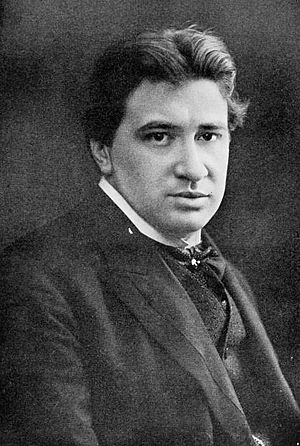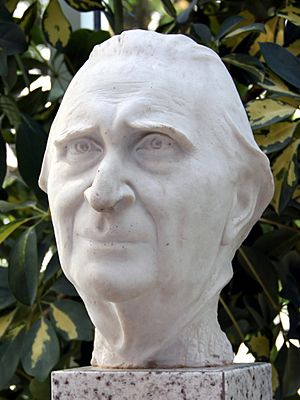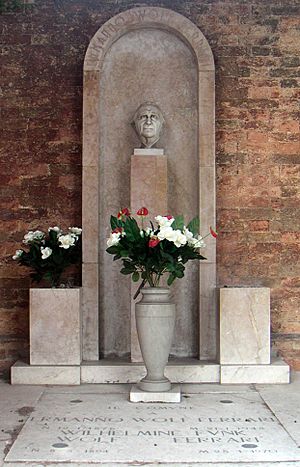Ermanno Wolf-Ferrari facts for kids
Ermanno Wolf-Ferrari (born Ermanno Wolf) was an Italian composer and teacher. He lived from January 12, 1876, to January 21, 1948. He is most famous for his funny operas, like Il segreto di Susanna (1909). Many of his works were based on plays by Carlo Goldoni, including Le donne curiose (1903), I quatro rusteghi (1906), and Il campiello (1936).
Contents
Life of a Composer
Ermanno Wolf-Ferrari was born in Venice in 1876. His father, August Wolf, was a German painter, and his mother, Emilia Ferrari, was from Venice. In 1895, he added his mother's last name, Ferrari, to his own.
Even though he started piano lessons early, music wasn't his main interest at first. As a teenager, Wolf-Ferrari wanted to be a painter, just like his father. He studied painting a lot in Venice and Rome. He also traveled to Munich to study art there.
It was in Munich that he decided to focus on music instead. He took lessons from Josef Rheinberger. He joined the Munich conservatory and began studying how to write music. These music classes soon became more important than his art studies. Music took over Wolf-Ferrari's life, and he wrote his first musical pieces in the 1890s.
When he was 19, Wolf-Ferrari left the conservatory and went back home to Venice. There, he worked as a conductor for choirs. He also got married and had a son named Federico. During this time, he met famous composers like Arrigo Boito and Verdi.
In 1900, Wolf-Ferrari's first opera, Cenerentola, was performed. It was based on the story of Cinderella. The opera was not successful in Italy. Feeling disappointed, the young composer moved back to Munich. German audiences liked his work more. A new version of Cenerentola was a hit in Bremen in 1902. His cantata La vita nuova also brought him international fame.
Wolf-Ferrari then started turning the funny plays of the 18th-century Venetian writer Carlo Goldoni into comic operas. These operas were full of different musical styles, catchy tunes, and were very funny. Every single one became a success around the world. In fact, before World War I began, Wolf-Ferrari's operas were among the most performed in the world. In 1902, he became a professor of composition and the director of the Liceo Benedetto Marcello.
In 1911, Wolf-Ferrari tried a different style called Verismo with his opera I gioielli della Madonna. This opera told a dramatic story of strong feelings and difficult situations. It was quite popular back then, especially in Chicago. The famous singer Rosa Raisa made it well-known there. Later, Maria Jeritza and Florence Easton also had great success with it at the Metropolitan Opera in 1926.
World War I was a very hard time for Wolf-Ferrari. He had been living part-time in Munich and part-time in Venice. Suddenly, his two countries were fighting each other. When the war started, he moved to Zurich. He composed much less during this time, but he still wrote another comedy called Gli amanti sposi (1916). After the war, his music became a bit sadder and more complex.
He didn't start composing a lot again until the 1920s. During this time, he wrote Das Himmelskleid (1925) and Sly (1927). Sly was based on William Shakespeare's play The Taming of the Shrew. In 1939, he became a professor of composition at the Mozarteum in Salzburg. In 1946, he moved to Zürich again before returning to his home city of Venice. He passed away in Venice at Palazzo Malipiero and is buried in the Venetian cemetery Island of San Michele.
His Music
Besides his operas, Wolf-Ferrari also wrote many instrumental pieces. He mostly wrote these at the very beginning and very end of his career. Only his violin concerto is performed regularly today.
He also wrote other works like Idillio-concertino (which is like a small symphony). He composed various pieces of chamber music, including a piano quintet and two piano trios. He also wrote three violin sonatas and several pieces for the organ. Recently, a pianist named Costantino Catena has been recording many of his instrumental works.
Wolf-Ferrari's music is not performed very often today, except for some of his overtures and a piece from his Jewels of the Madonna opera. However, he is generally seen as one of the best Italian comic opera composers of his time. His works often remind people of the funny opera buffa style from the 18th century. He also wrote more serious works, similar to those by Pietro Mascagni, but these are not as well-known.
Works
Operas
- See List of operas by Ermanno Wolf-Ferrari
Other Vocal Works
- La vita nuova, cantata 1902
- 4 Rispetti, Op. 11
- 4 Rispetti, Op. 12
- Canzoniere, Op. 17
Orchestral Music
- Serenade for Strings in E flat major
- Idillio-concertino in A major for Oboe and small orchestra, Op. 15 (1932)
- Suite-concertino in F major for Bassoon and small orchestra, Op. 16 (1933)
- Venezianische Suite (Venetian Suite) in A minor, Op.18
- Triptychon (Triptych) op.19
- Divertimento in D major op.20
- Arabesken (Arabesques) for Orchestra op.22 (based on a theme by Ettore Tito)
- Violin Concerto in D, Op. 26 Guila Bustabo in ammirazione (1943)
- Sinfonia Brevis in E flat major op.28
- Concertino in A flat major for English horn and small orchestra, Op. 34 (1947)
Chamber Music
- String Sextet in C minor (1894/95, also as a string trio)
- Sinfonia da Camera Op. 8 (1901)
- Sonata No.1 for Violin & Piano in G minor, Op.1 (1895)
- Sonata No.2 for Violin & Piano in A minor, Op.10 (1901)
- Sonata No.3 for Violin & Piano in E major, Op.27 (1943)
- Sonata for Cello & Piano in G major, Op.30 (1945)
- String Duo in G minor for Violin & Cello, Op.33b (1946)
- String Duo, "Introduzio mnjkkjkne e Balletto", for Violin & Cello, Op.35 (1948)
- String Trio in B minor for Violin, Viola & Cello, WoO. (1894)
- String Trio in A minor for Violin, Viola & Cello, Op.32 (1945)
- String Quartet in E minor, Op.23 (1940)
- String Quintet in C major for 2 Violins, 2 Violas & Cello, Op.24 (1942)
- Piano Trio No.1 in D major, Op.5 (1898)
- Piano Trio No.2 in F♯ major, Op.7 (1900)
- Piano Trio "Sonata" for in F major for 2 Violins & Piano, Op.25 (1943)
- Piano Quintet in D♭ major, Op.6 (1901)
See also
 In Spanish: Ermanno Wolf-Ferrari para niños
In Spanish: Ermanno Wolf-Ferrari para niños




